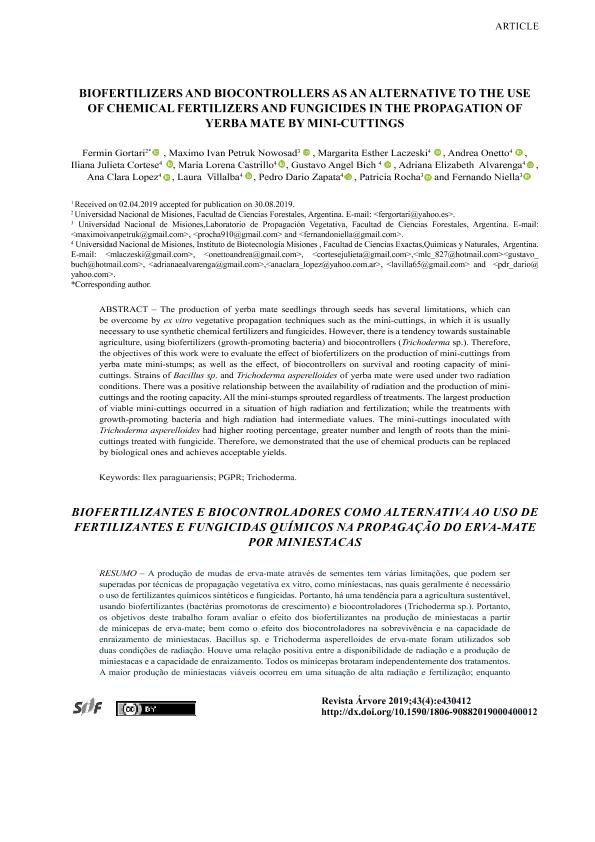Artículo
The production of yerba mate seedlings through seeds has several limitations, which canbe overcome by ex vitro vegetative propagation techniques such as the mini-cuttings, in which it is usuallynecessary to use synthetic chemical fertilizers and fungicides. However, there is a tendency towards sustainableagriculture, using biofertilizers (growth-promoting bacteria) and biocontrollers (Trichoderma sp.). Therefore,the objectives of this work were to evaluate the eff ect of biofertilizers on the production of mini-cuttings fromyerba mate mini-stumps; as well as the eff ect, of biocontrollers on survival and rooting capacity of minicuttings. Strains of Bacillus sp. and Trichoderma asperelloides of yerba mate were used under two radiationconditions. There was a positive relationship between the availability of radiation and the production of minicuttings and the rooting capacity. All the mini-stumps sprouted regardless of treatments. The largest productionof viable mini-cuttings occurred in a situation of high radiation and fertilization; while the treatments withgrowth-promoting bacteria and high radiation had intermediate values. The mini-cuttings inoculated withTrichoderma asperelloides had higher rooting percentage, greater number and length of roots than the minicuttings treated with fungicide. Therefore, we demonstrated that the use of chemical products can be replacedby biological ones and achieves acceptable yields. A produção de mudas de erva-mate através de sementes tem várias limitações, que podem ser superadas por técnicas de propagação vegetativa ex vitro, como miniestacas, nas quais geralmente é necessário o uso de fertilizantes químicos sintéticos e fungicidas. Portanto, há uma tendência para a agricultura sustentável, usando biofertilizantes (bactérias promotoras de crescimento) e biocontroladores (Trichoderma sp.). Portanto, os objetivos deste trabalho foram avaliar o efeito dos biofertilizantes na produção de miniestacas a partir de minicepas de erva-mate; bem como o efeito dos biocontroladores na sobrevivência e na capacidade de enraizamento de miniestacas. Bacillus sp. e Trichoderma asperelloides de erva-mate foram utilizados sob duas condições de radiação. Houve uma relação positiva entre a disponibilidade de radiação e a produção de miniestacas e a capacidade de enraizamento. Todos os minicepas brotaram independentemente dos tratamentos. A maior produção de miniestacas viáveis ocorreu em uma situação de alta radiação e fertilização; enquanto os tratamentos com bactérias promotoras de crescimento e alta radiação apresentaram valores intermediários. As miniestacas inoculadas com Trichoderma asperelloides apresentaram maior porcentagem de enraizamento, maior número e longitude de raízes que as miniestacas tratadas com fungicida. Portanto, provamos que o uso de produtos químicos pode ser substituído por produtos biológicos e esse fato atingem alcança rendimentos aceitáveis.
Biofertilizers and biocontrollers as an alternative to the use of chemical fertilizers and fungicides in the propagation of yerba mate by mini-cuttings
Título:
Biofertilizantes e biocontroladores como alternativa ao uso de fertilizantes e fungicidas químicos na propagação do erva-mate por miniestacas
Gortari, Fermin ; Nowosad, Maximo Ivan Petruk; Laczeski, Margarita Ester
; Nowosad, Maximo Ivan Petruk; Laczeski, Margarita Ester ; Onetto, Andrea; Cortese, Iliana Julieta
; Onetto, Andrea; Cortese, Iliana Julieta ; Castrillo, María Lorena
; Castrillo, María Lorena ; Bich, Gustavo Angel
; Bich, Gustavo Angel ; Alvarenga, Adriana Elizabeth; Lopez, Ana Clara
; Alvarenga, Adriana Elizabeth; Lopez, Ana Clara ; Villalba, Laura; Zapata, Pedro Dario
; Villalba, Laura; Zapata, Pedro Dario ; Rocha, Patricia; Niella, Fernando Omar
; Rocha, Patricia; Niella, Fernando Omar
 ; Nowosad, Maximo Ivan Petruk; Laczeski, Margarita Ester
; Nowosad, Maximo Ivan Petruk; Laczeski, Margarita Ester ; Onetto, Andrea; Cortese, Iliana Julieta
; Onetto, Andrea; Cortese, Iliana Julieta ; Castrillo, María Lorena
; Castrillo, María Lorena ; Bich, Gustavo Angel
; Bich, Gustavo Angel ; Alvarenga, Adriana Elizabeth; Lopez, Ana Clara
; Alvarenga, Adriana Elizabeth; Lopez, Ana Clara ; Villalba, Laura; Zapata, Pedro Dario
; Villalba, Laura; Zapata, Pedro Dario ; Rocha, Patricia; Niella, Fernando Omar
; Rocha, Patricia; Niella, Fernando Omar
Fecha de publicación:
02/2020
Editorial:
Universidade Federal Vicosa. Sociedade de Investigacoes Florestais
Revista:
Revista Arvore
ISSN:
0100-6762
e-ISSN:
1806-9088
Idioma:
Inglés
Tipo de recurso:
Artículo publicado
Clasificación temática:
Resumen
Palabras clave:
ILEX PARAGUARIENSIS
,
PGPR
,
TRICHODERMA
Archivos asociados
Licencia
Identificadores
Colecciones
Articulos(CCT - NORDESTE)
Articulos de CTRO.CIENTIFICO TECNOL.CONICET - NORDESTE
Articulos de CTRO.CIENTIFICO TECNOL.CONICET - NORDESTE
Citación
Gortari, Fermin; Nowosad, Maximo Ivan Petruk; Laczeski, Margarita Ester; Onetto, Andrea; Cortese, Iliana Julieta; et al.; Biofertilizers and biocontrollers as an alternative to the use of chemical fertilizers and fungicides in the propagation of yerba mate by mini-cuttings; Universidade Federal Vicosa. Sociedade de Investigacoes Florestais; Revista Arvore; 43; 4; 2-2020; 1-12
Compartir
Altmétricas



